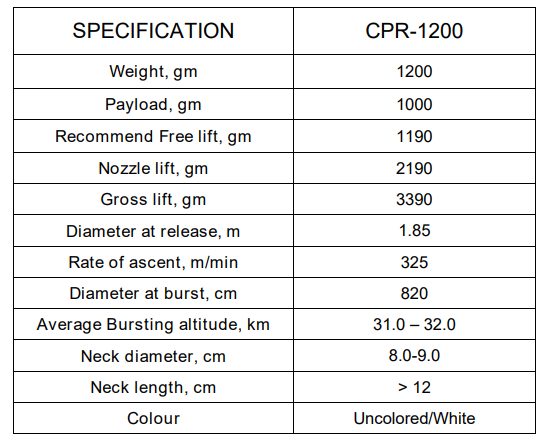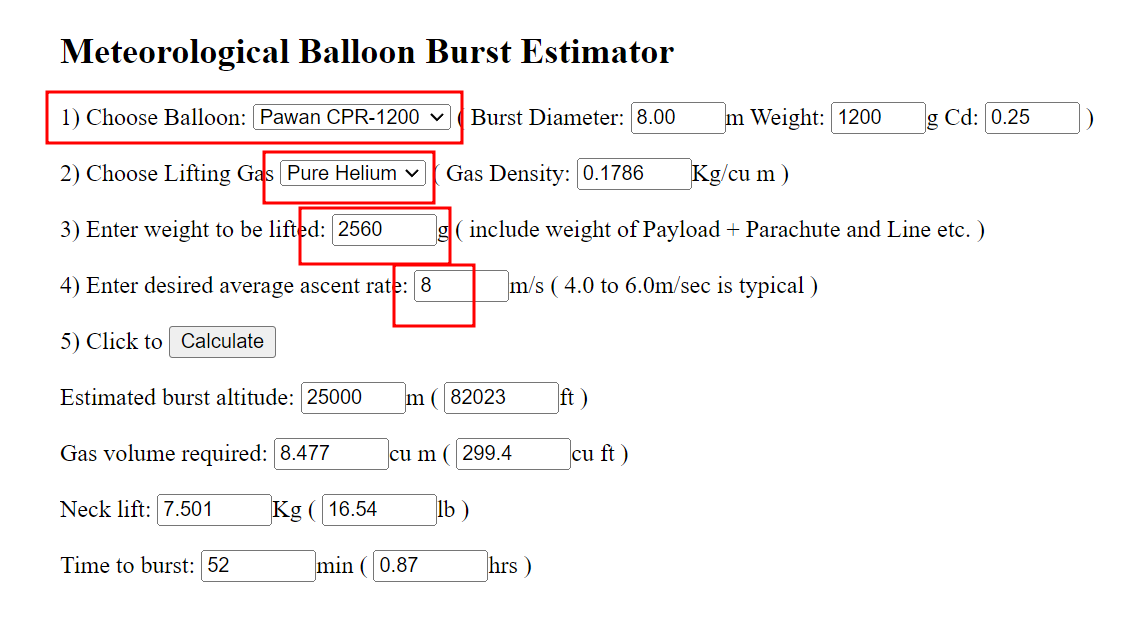HAB Calculation HELP
Shivaram S P
My balloon specification :



How I have planned to launch the balloon : https://youtu.be/6_06Q_eWta8
Steve
Here are a few comments
Steve G8KHW
My payload weight include weight of Payload + Parachute and Line etc. will be 2560g
I calculated by Burst altitude : http://www.randomengineering.co.uk/Random_Aerospace/Balloons.html
I predicted with : https://predict.sondehub.org/And how accurate is this predict sondehub ?
I don't know how to find out my Descent Rate with my parachute (m/s): Can anyone let me know how to calculate.
SR: to calculate descent rate you need to know the Cd
(coefficient of drag) for your parachute - which will be dependent
on its design (Parasheet/Hemispherical/Parabolic spill holes ...
etc.). The manufacturer should know this - I find it surprising
it (or descent rate) is not listed in the data. A 3m chute seems a
bit big for a 2.5Kg payload (as implied by the Payload Range
data). Too big is no real problem if you don't mind traveling
further to recover it.
There is a Parachute descent rate calculator here:
http://randomaerospace.com/Random_Aerospace/Parachutes.html.
How I have planned to launch the balloon : https://youtu.be/6_06Q_eWta8calculate lift for a weather balloon : https://youtu.be/NxwlNnfKMHs
How to fill a weather balloon : https://youtu.be/5Z23L4QIgtQ
SR: those generally seem OK (I didn't have time to watch them all through). Personally I would not use the Free lift = 1.5x all up weight advice and calculate free lift using the Burst Calculator. But what he says is golden:- overfill rather than underfill. The desired 8m/sec ascent rate (In the burst estimator) is very high unless you have some specific reason. Such a high rate is generally a waste of gas and makes a lot of turbulence (which results in payload movement - bad for any video footage if that's an aim). I aim for 5.5m/sec these days.
Dave A's guides are a good starting point:
http://www.daveakerman.com/?p=1732
Shivaram S P
- Predication accuracy : I have taken a note on this
- calculate descent rate : I contacted my manufacturer and asked I want to know the details for the field : Chute "Coefficent of Drag x Area" to calculate my descent speed / They replied : This is closer to a hemispherical parachute and Cd will be around 1.5, Considering that the shape is hemispherical the area can be calculated using the canopy diameter given in the specifications. Can you help me on this if possible ?
- I have also changed my ascend speed to 5.5m/sec.
John Laidler
--
You received this message because you are subscribed to the Google Groups "UKHAS" group.
To unsubscribe from this group and stop receiving emails from it, send an email to ukhas+un...@googlegroups.com.
To view this discussion on the web visit https://groups.google.com/d/msgid/ukhas/8fd4c43b-38f0-4fab-91fa-38bfb4ec2725n%40googlegroups.com.
Shivaram S P
I made this calculation. But I don't think its right. Can you correct me where I am making a mistake
Payload: 2100 grams
Coefficient of Drag (Cd): 1.5 (as provided by the manufacturer)
Canopy Diameter: 300 cm
Air Density (r): Approximately 1.225 kg/m³ (average at sea level)
Step 1: Convert Payload to Newtons
Payload in Newtons (N) = (2100 grams / 1000) * 9.81 m/s² ≈ 20.58 N
Step 2: Calculate Area of the Parachute in Flight
Area of Parachute (A) = π * (Canopy Diameter / 2)^2
A = π * (300 / 2)^2 ≈ 706.86 cm² ≈ 0.0707 m²
Step 3: Calculate Descent Rate (m/s)
Descent Rate (V) = √(D / (Cd * A * 0.5 * r))
Substitute the values:
V = √(20.58 N / (1.5 * 0.0707 m² * 0.5 * 1.225 kg/m³))
V ≈ √(20.58 N / 0.0530 kg*m²/s²)
V ≈ √(388.68 m²/s²)
V ≈ 19.72 m/s (approximately)
David Akerman
To view this discussion on the web visit https://groups.google.com/d/msgid/ukhas/3be35c27-2e4f-4b59-a2a9-e370cf8cc6can%40googlegroups.com.
Steve
You will find a lot of guff about parachute areas and Cd on the
internet. Do not use Cd as a way of comparing parachutes
effectiveness unless the manufacturer tells you the way
Area is being calculated and how that relates to their "size"
measurement. What the parachute reference area A is seems to vary
from manufacturer to manufacturer:
e.g. one manufacturer might measure area as cross sectional area (CSA) in flight and have a Cd of X - but a different manufacturer might measure the Surface Area (SA) of the same parachute design and have a Cd of Y. By choosing to use CSA rather than Surface Area (SA) you can get a higher Cd number and make the parachutes look better on paper. For a hemispherical chute the SA will be double the CSA (and hence SA measured Cd will be half of that CSA).
Which method is correct? - I believe the professionals use
Surface Area.
Also - what is the dimension the parachute "size" is measured and how is this turned into a reference area (that they are measuring Cd against).
To view this discussion on the web visit https://groups.google.com/d/msgid/ukhas/CAJn3SCoTcaTm%2BApCrhfEf9XTCxzCms4YJdFScSV_Kdk1v3Cw0Q%40mail.gmail.com.
Steve
If the parachute is one of these (T-PF01-290):
http://nwzimg.wezhan.cn/contents/sitefiles2045/10226828/images/20013375.jpg
Then its probably a para-sheet (a single circular sheet of fabric with lines attached) - the diameter is probably that of the sheet laid flat.
Para-sheets are said to have a Cd of about 0.75 using the sheet surface area as a reference. (The claimed 1.5 must be relative to in flight CSA).
In general para-sheets perform poorly relative to their size and
weight - as Dave says generally a 3m chute would be considered
huge for 2.1Kg of payload.
So surface area A = Pi * D / 4 = 3.142 * 3.0 / 4 = 2.3565 sq m
The payload + parachute weight is 2.1Kg + 0.37Kg = 2.47Kg *
9.81 = 24.231 Newtons of force
using rho of 1.225Kg/cu m
V = SQRT( (W * 9.81) / (Cd * A * 0.5 * rho))
V = SQRT (24.231 / (0.75 * 2.3565 * 0.5 * 1.225) = 4.7m/sec
Steve
To view this discussion on the web visit https://groups.google.com/d/msgid/ukhas/3be35c27-2e4f-4b59-a2a9-e370cf8cc6can%40googlegroups.com.
John Laidler
To view this discussion on the web visit https://groups.google.com/d/msgid/ukhas/3be35c27-2e4f-4b59-a2a9-e370cf8cc6can%40googlegroups.com.
Steve
The chute is 3.0m (300cm) in diameter:

Steve
To view this discussion on the web visit https://groups.google.com/d/msgid/ukhas/CAJn3SCprnLbOQ_zSzh-bzqaPFyRutaLwKzvVdQWE6XSRAHDQCg%40mail.gmail.com.
David Akerman
To view this discussion on the web visit https://groups.google.com/d/msgid/ukhas/CAJn3SCprnLbOQ_zSzh-bzqaPFyRutaLwKzvVdQWE6XSRAHDQCg%40mail.gmail.com.
John Laidler
To view this discussion on the web visit https://groups.google.com/d/msgid/ukhas/CAN3_bBpgQdXQZphg6uWg_-SBQJWxkgp1aXMqXu55_vqZx6--PQ%40mail.gmail.com.
